Categories
Subjects
Authors
Artists
Venues
Locations
Calendar
Filter
Done
March 15, 2024 – Review
Mary Helena Clark’s “Conveyor”
Chris Murtha
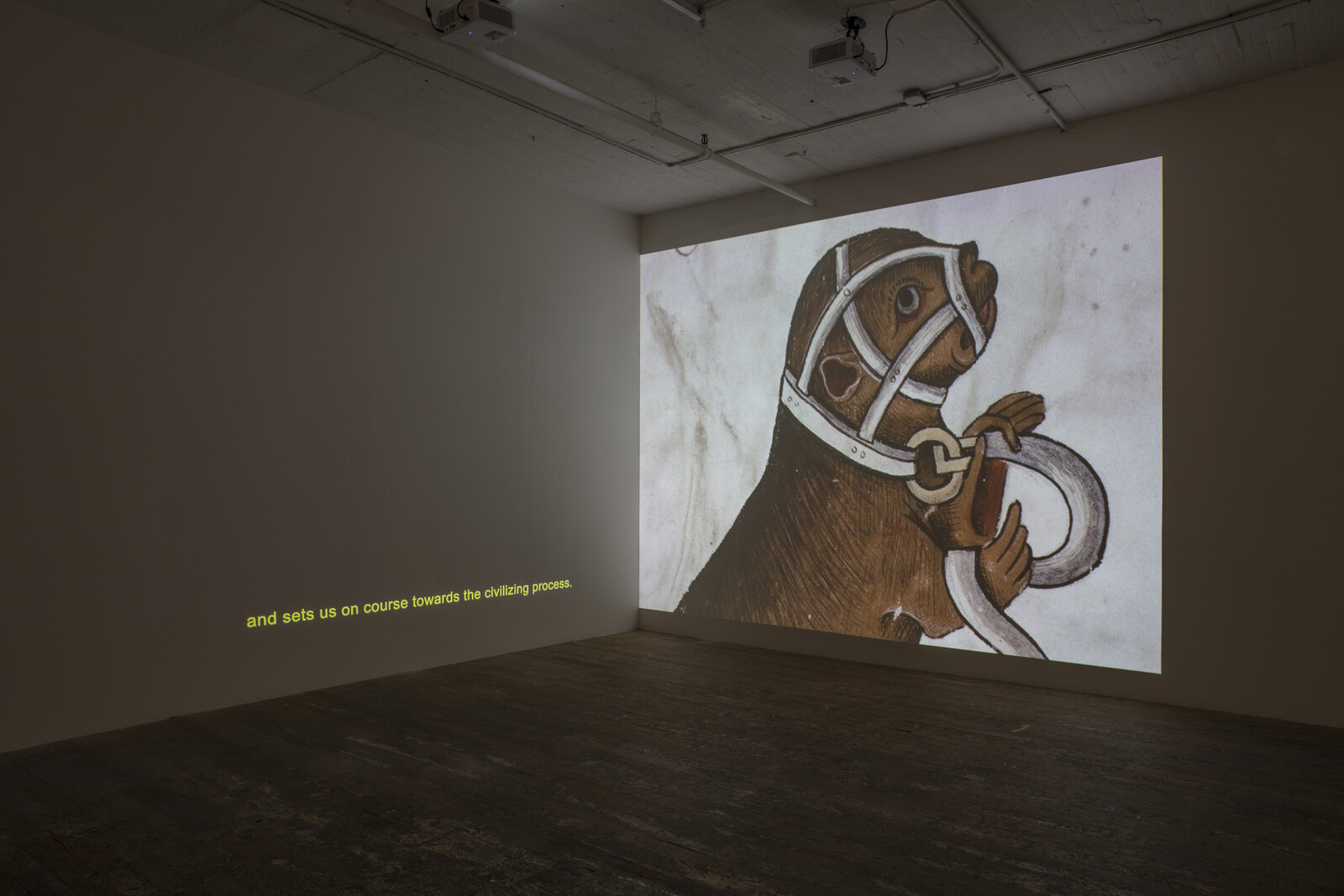
There’s a card trick midway through Mary Helena Clark’s Neighboring Animals (all works 2024 unless otherwise stated), a two-channel video projected into a darkened corner. While an elderly orangutan watches from the other side of his enclosure’s window, two human hands press a single playing card against the thick safety glass. Holding a stick in one hand, the ape nimbly picks up the card, now (miraculously!) on his side of the barrier. After giving it a sniff and twirling it around in his hands, he places it back on the glass, tapping it a few times with his makeshift wand—perhaps his attempt to send it back through the seemingly porous window. Clark edited this video—a zoo’s promotional clip gone viral—to preserve some mystery on behalf of the orangutan, cutting the ending so that the card, instead of falling to the ground, remains affixed to the glass.
A collage of sampled footage, still pictures, medical scans, and her own camerawork, Neighboring Animals scrutinizes the thresholds between inside and outside, human and beast. The left channel consists solely of yellow subtitles with no corresponding voice, a pastiche of quotations on the topic of disgust. Alongside illustrations of chained and leashed animals from …
July 27, 2020 – Feature
New York City Roundup
Terence Trouillot
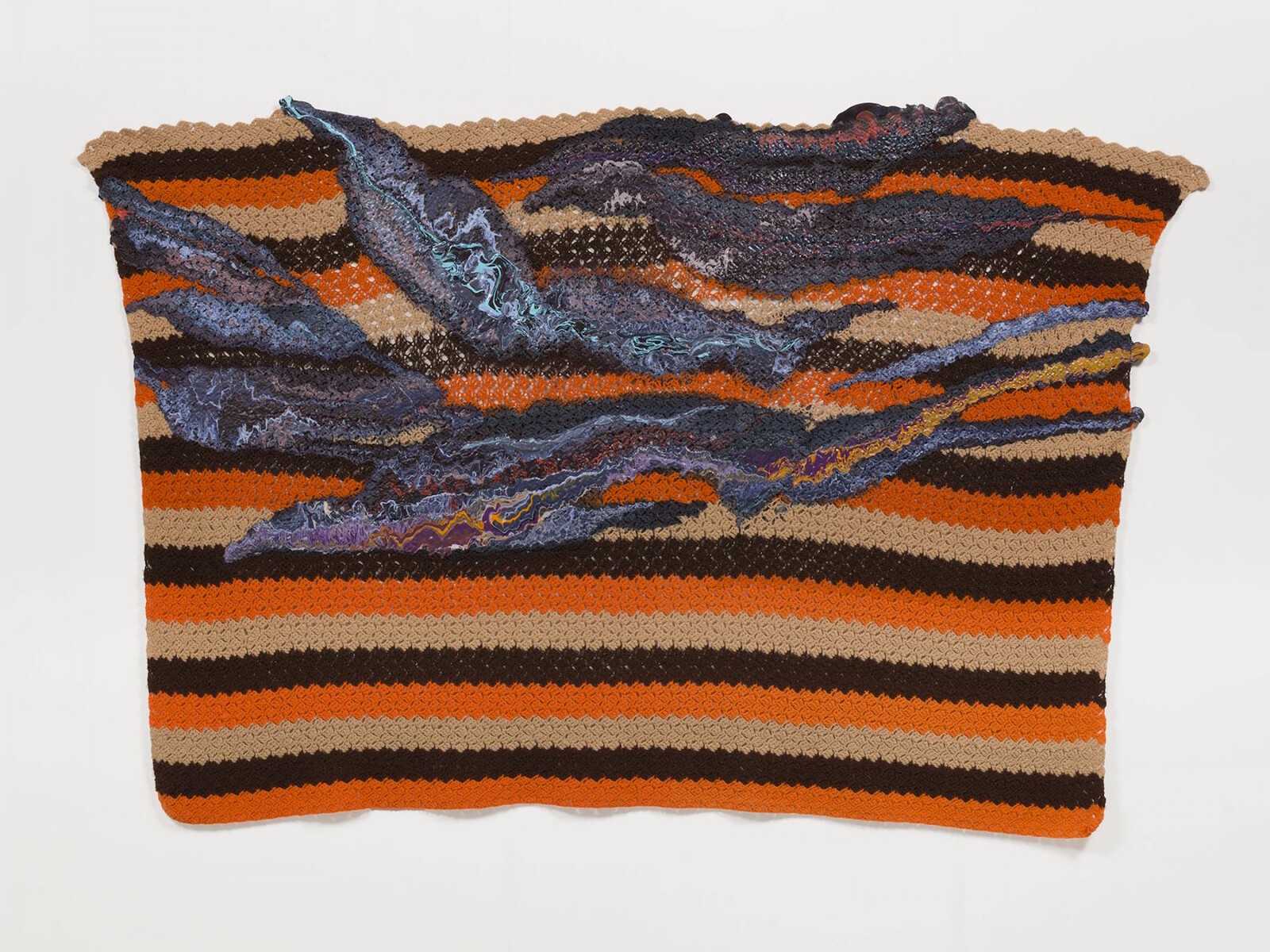
I didn’t think I’d be this excited to go back to a gallery. In some ways, I’ve enjoyed experiencing art within the confines of my Brooklyn apartment over the past months, and I’m still excited by the possibilities arising from the advent of novel digital platforms. But this time away from real-life art viewing has made the experience a novelty, and as galleries started to reopen it felt like a much-needed indulgence—after months of social distancing, and then weeks of defying said social distancing to protest in the streets against the most recent examples of state-sanctioned violence against Black bodies—simply to be back.
At “Jack Whitten. Transitional Space. A Drawing Survey.” at Hauser & Wirth on the Upper East Side—an exhibition which outlines Whitten’s exceptional works on paper chronologically, from the 1960s to the 2010s—I was surprised by the boyish glee I felt just at noticing the pronounced physicality of paper: the deckled edges, the wrinkle in the page, the raised contours of paper cut-outs collaged onto another flat surface. The show demonstrates the careful evolution in Whitten’s work from figuration to abstraction, but also focuses on the artist’s attention to material, and the various techniques that make his later …
December 20, 2018 – Review
Eileen Myles’s “poems”
Alan Gilbert
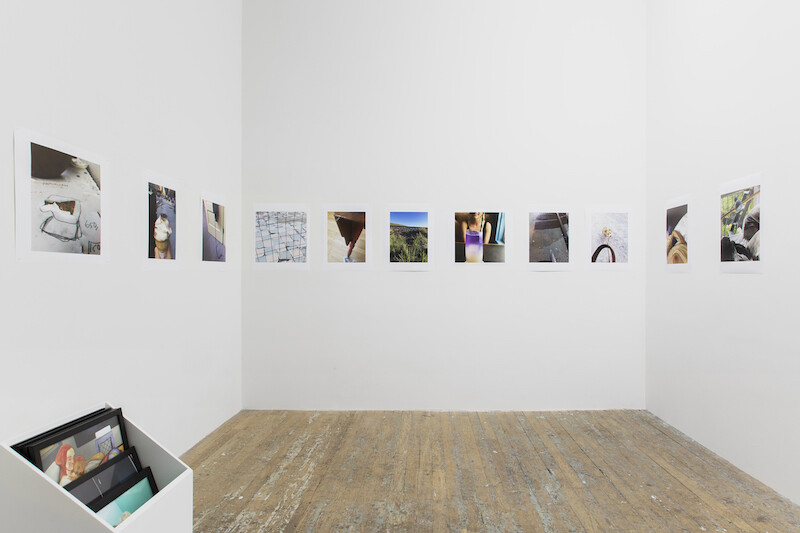
It’s so easy to ignore what’s directly in front of you when it seems more sullied than that which is imagined to be just beyond a particular moment or place. Digital technologies seek to eradicate this gap by making a better or more convenient life, via an image or purchase, only a click away. In the process, desire is replaced by need as online streams of ads and information, many of which are targeted to sell some sort of aspirational product or lifestyle, arrive with greater speed and density—not for nothing are these streams called feeds. At the same time, social media has created spaces for alternative communities, identities, and politics that refuse the increasingly tenuous status quo. And while their cooptation can happen quickly, and their tracking—the consumer-friendly word for surveillance—is ubiquitous, these spaces are also seedbeds for a different world.
The most striking visual aspect of the photographs from the writer Eileen Myles’s Instagram account (@eileen.myles) currently on display as enlarged (ca. 24 x 18 inches) digital prints at Bridget Donahue is how oriented they are on the image’s frequently messy foreground. In the selection of 20 photographs (out of more than 6000 on Myles’s Instagram), this foreground includes …
January 31, 2018 – Review
Sondra Perry
Natasha Marie Llorens
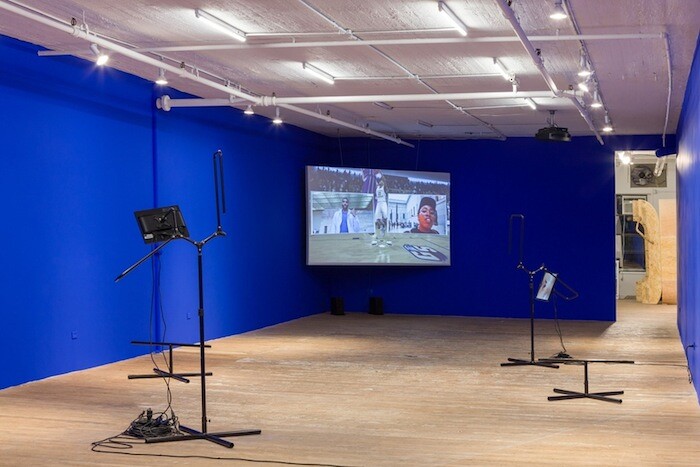
For Sondra Perry’s solo exhibition at Bridget Donahue, New York, all the walls are painted Rosco Chroma Key Blue. The deeply saturated color is used on television sets and in the production of special effects for movies and videogames because it contrasts so profoundly with most human skin colors. Chroma Key Blue is the obverse of the color of being, Sondra Perry pointed out to me at the opening. No human skin exists in an adjacent shade, and so it can be used as the negative space onto which context for any body can be manufactured and projected. The color of ultimate negativity, or the absence of existence.
Perry’s interest in the condition of visibility is influenced in part by Simone Browne’s Dark Matters: On the Surveillance of Blackness (2015), which analyzes the way people of color are visualized using surveillance technologies and, through this visualization, de-humanized. Browne traces the containment of blackness from basic technologies, such as branding and lantern laws, to more technically advanced forms used in contemporary policing.
Black bodies are often represented in the aforementioned visualization techniques against a ground very similar to Rosco Chroma Key Blue: one of the conditions of their visibility since slavery has been …
March 9, 2017 – Review
Lynn Hershman Leeson’s “Remote Controls”
Alan Gilbert

One day the interface between humans and computers will be seamless. For now, it involves necks bent over smartphones, hours sitting hunched in front of a monitor, fingers and arms that still need to extend toward their devices. Despite all the talk about disembodied experiences and virtual worlds, computer technology hasn’t superseded the physical body; instead, it’s subtly reshaping it, including neurochemistry. Nevertheless, some new media and digital art treats computers as if they’re mostly tools for creating shiny images and scrolling animations, especially when abstraction is added to the mix. Many of these works can feel like painting and video simply updated for the electronic age.
The first audio track encountered upon entering Lynn Hershman Leeson’s exhibition “Remote Controls” at Bridget Donahue is the phrase “touch me.” It emanates from Deep Contact (1984–89), described on the exhibition checklist as the “earliest touchscreen”—i.e., the first artwork to utilize an operational touchscreen. Hershman Leeson has always been at the forefront of incorporating new technologies into her work (checklist descriptions also mention “earliest digital editing software” [Seduction of a Cyborg, 1994], “earliest emotional engine to reflect stock market data” [Synthia Stock Ticker, 2000–2], and “earliest interactive LaserDisc” [Lorna, 1979–84]), but accompanying this exploration …
January 5, 2016 – Review
John Russell’s “SQRRL”
Alan Gilbert
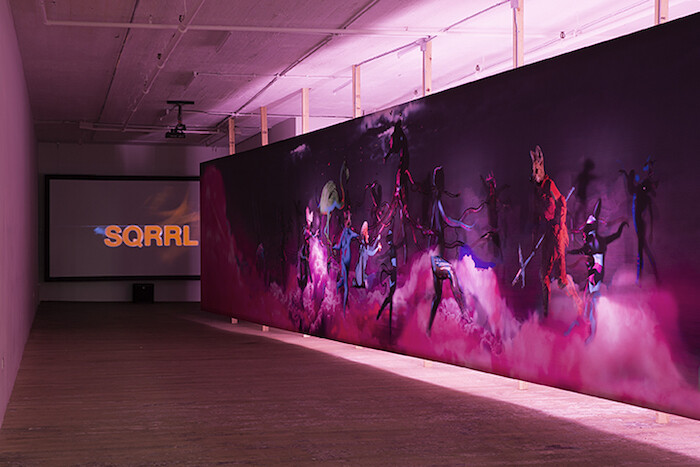
If after finishing this review you visit Bridget Donahue’s website to learn more about John Russell’s current exhibition, “SQRRL,” you’ll find a brightly hued digital collage of image and text in the place of a static gallery homepage with its neatly tabbed categories linking to exhibitions, artists, about, and contact information. Hybrid imagery featuring animals, humans, and robots is illustrated by short, cryptic texts, such as “CarlEee sits sipping coffee. / 195 years old. / Forty-five body allocations / Since the Starvation Wars of 87.” These, in turn, are explicated by 33 footnotes and a bibliography in the right-hand margin that unfolds a sci-fi-esque allegory of the present in which a predatory digital realm becomes the new organic as the human—and its various modes of social and epistemological organization—collapses in its wake. Along with slyly serving as an online artwork in the exhibition, it also functions as the show’s press release.
If you visit Bridget Donahue proper, you’ll find a 45-minute digitally animated projected video version of the web page entitled Relaxation Video: SQRRL/BRUCE WILLIS (2015) with ambient soundtrack and Russell whispering parts of the script. Beginning relatively bucolically, and with short poetic descriptions, the work vividly depicts the cyborgization of …
